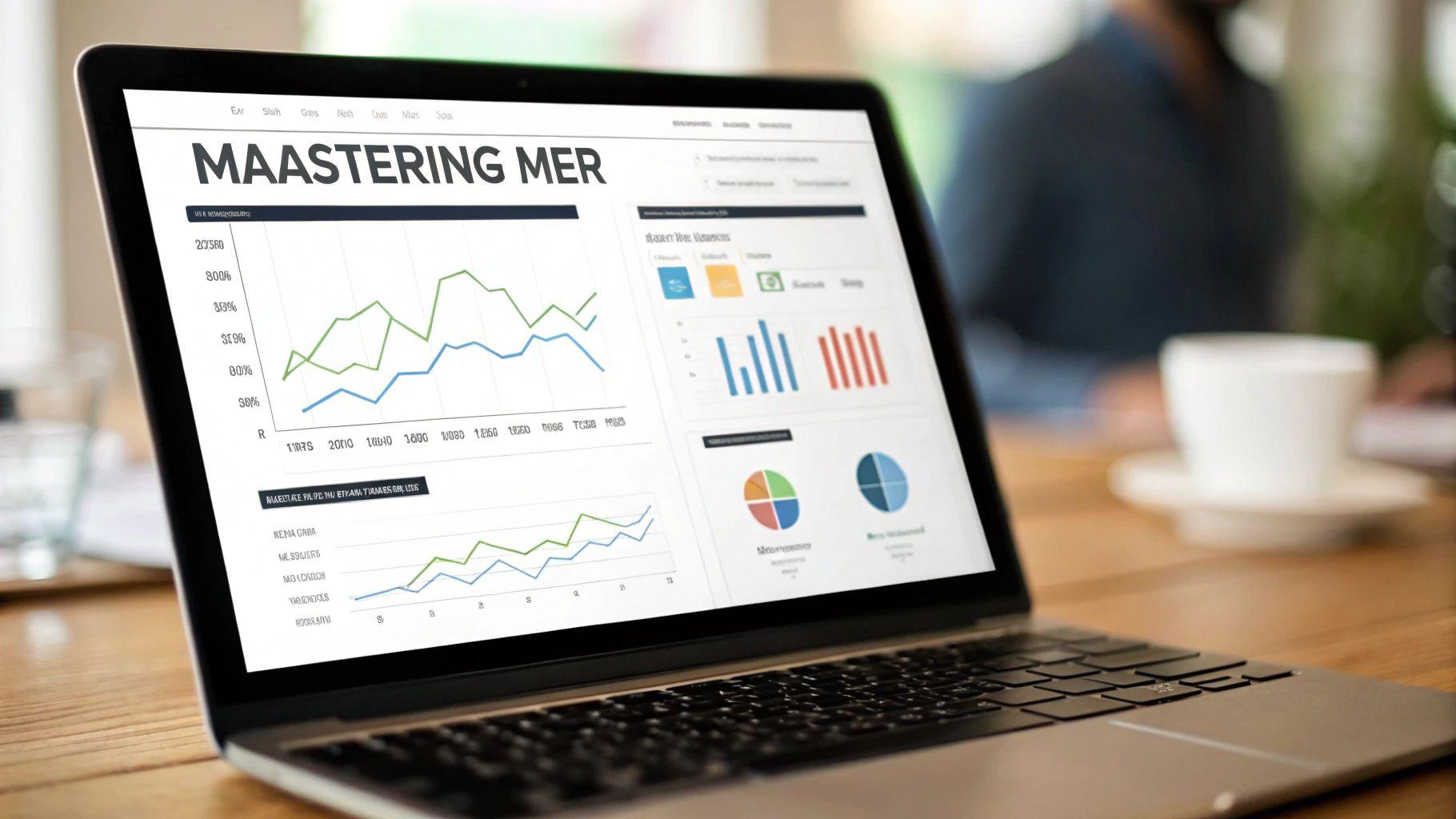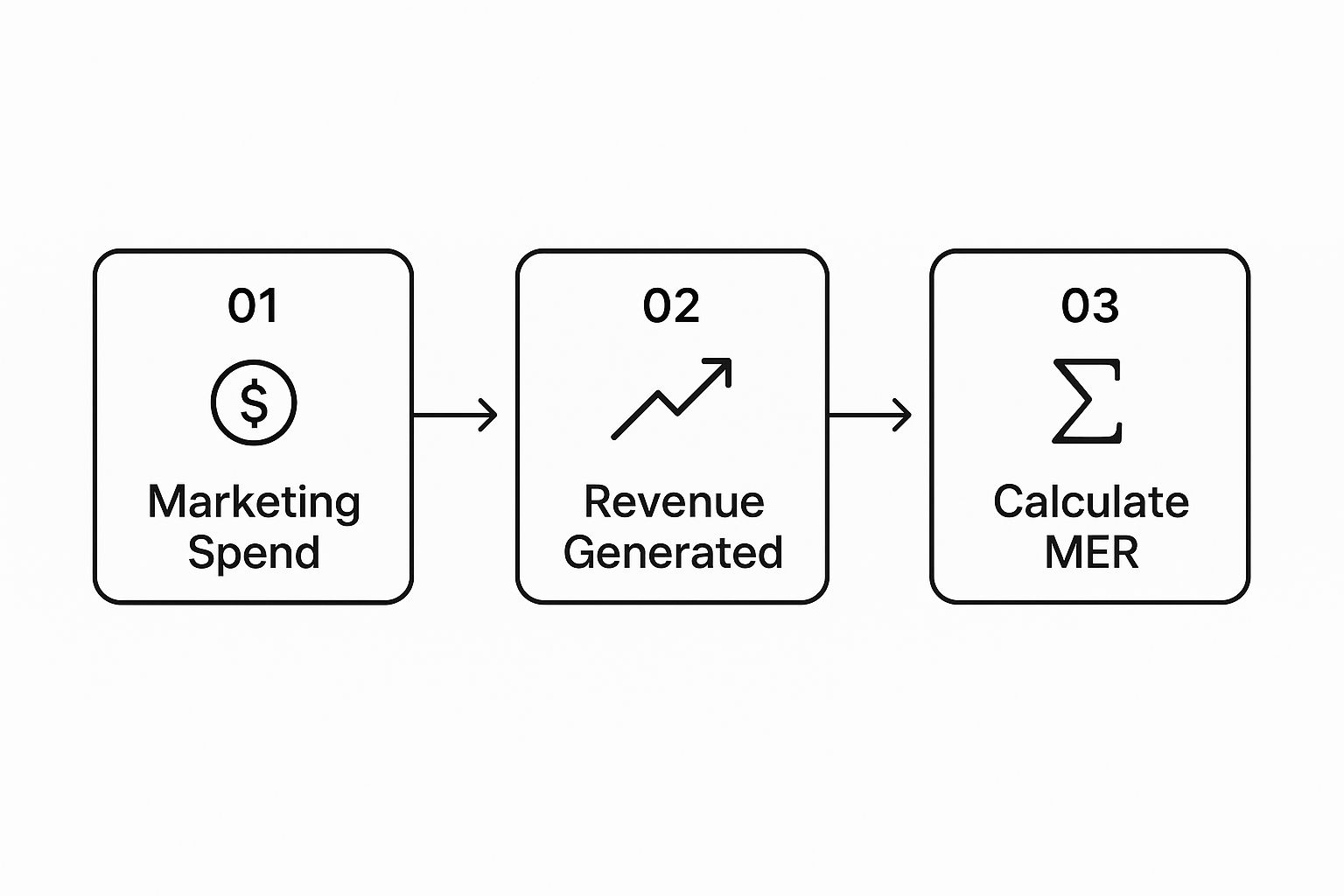Mastering the Marketing Efficiency Ratio
Unlock profitable growth with the marketing efficiency ratio. Learn how to calculate MER, set benchmarks, and use it to scale your marketing spend wisely.

Ever felt like you're drowning in a sea of marketing acronyms? CPC, CPA, ROAS... they all tell you something, but what do they tell you about the big picture? That's where the Marketing Efficiency Ratio, or MER, comes in.
Think of it this way: MER is the ultimate health check for your entire marketing department. It steps back from the individual campaigns and asks a simple, powerful question: for every single dollar we spend on marketing, how many dollars in total revenue are we bringing back into the business?
It’s your business’s equivalent of "miles per gallon." While other metrics are busy checking the spark plugs and tire pressure, MER tells you how efficiently your entire engine is running.
What Is the Marketing Efficiency Ratio?

At its core, the Marketing Efficiency Ratio gives you a bird's-eye view of your performance. It deliberately ignores the complex, often messy world of attribution models and channel-specific data. Instead of getting bogged down in whether a sale came from a Facebook ad or an email newsletter, MER looks at the blended impact of everything you do.
This holistic view is what makes MER so valuable for making smart, sustainable decisions about growth.
Understanding the "True North" Metric
MER is often called a "true north" metric because it keeps your business pointed squarely at profitability. It's an honest broker. It forces you to account for every marketing cost—not just your ad spend, but also agency retainers, software subscriptions, and even the salaries of your marketing team. You then weigh that total investment against your total revenue.
This isn't a new concept. Businesses have long used this ratio to see how well their spending converts into sales. For example, if a company invests $50,000 in all its marketing efforts and generates $200,000 in total revenue, its MER is 4x. This means for every $1 spent, it earned $4 back. Simple as that. You can dig deeper into the fundamentals over on Mailchimp's blog.
By focusing on your overall marketing efficiency ratio, you shift from chasing vanity metrics to building a genuinely profitable business. It provides a clear, honest look at what’s really driving growth.
To make this crystal clear, here’s a quick breakdown of what goes into the Marketing Efficiency Ratio.
MER at a Glance
This table breaks down the core components of the Marketing Efficiency Ratio for quick understanding.
| Component | Description | Example |
|---|---|---|
| Total Revenue | This is the top-line revenue for your entire business over a specific period (e.g., a month or quarter). It’s not just sales from ads. | A business generates $100,000 in total sales in March. |
| Total Marketing Spend | This includes all costs associated with marketing, both direct and indirect. | Ad spend ($15k), agency fees ($5k), and marketing software ($1k) = $21,000 total spend. |
| The Ratio | The final number that shows your return for every dollar spent. It's calculated as Total Revenue / Total Marketing Spend. | $100,000 / $21,000 = a MER of approximately 4.76x. |
This table shows just how straightforward the metric is, which is a huge part of its power.
Why It Matters More Than Ever
In a world where privacy changes are making it harder to track every customer touchpoint, MER's simplicity is its strength. It doesn't need perfect attribution or tracking cookies to be incredibly useful. It measures the direct relationship between what you spend and what you earn, making it a stable and reliable indicator of your marketing's health.
This is your starting point for smarter marketing. The key benefits are clear:
- A Holistic View: It assesses the combined effect of all your marketing channels, from paid ads and SEO to your email list.
- Simple Reporting: It's a clean, high-level KPI that executives and stakeholders can immediately grasp. No deep-dive explanation needed.
- Smarter Budgeting: Tracking MER over time helps you spot trends in your overall efficiency, guiding high-level decisions about where to allocate your budget next quarter or next year.
Ultimately, keeping a close eye on your marketing efficiency ratio helps you invest with confidence, knowing your marketing dollars are truly working for you.
How to Calculate Your Marketing Efficiency Ratio
One of the best things about the marketing efficiency ratio is its simplicity. You don't need complicated spreadsheets or tracking tools to get a baseline. It's a high-level, honest look at what your marketing is actually producing.
The formula is incredibly straightforward:
Marketing Efficiency Ratio (MER) = Total Revenue / Total Marketing Spend
What you get is a single number, usually shown as a multiplier like 5x or 10x. This tells you exactly how many dollars in revenue you're generating for every single dollar you put into your marketing. The only rule is to make sure your revenue and spending figures cover the exact same time frame, whether it's a week, a month, or a quarter.
This simple visual breaks down the calculation process from start to finish.

As you can see, it really just comes down to grabbing your total marketing costs and your total revenue to get that final MER figure.
Defining Your Total Marketing Spend
The accuracy of your MER hinges on what you include in your "Total Marketing Spend." This is where people often make mistakes. It’s so much more than just your ad budget. For a true picture, you need to account for every dollar that supports your marketing efforts.
A complete calculation should include:
- Ad Spend: The obvious one. This is all your paid media costs across platforms like Amazon PPC, Google Ads, and social media.
- Agency Fees: If you work with an agency or consultant, their retainers and project fees count.
- Software and Tools: Don't forget your subscriptions for analytics, email, SEO, or any other marketing-related software.
- Content Creation Costs: Any money spent on photographers, videographers, copywriters, or influencers.
- Team Salaries: A portion of the salaries for your in-house marketing staff.
Adding all these up gives you the real denominator for your MER formula. It stops you from accidentally inflating your efficiency and gives you a number you can actually trust.
An Example MER Calculation in Action
Let's walk through a quick example. Imagine an e-commerce brand that sells primarily on Amazon wants to figure out its MER for the third quarter (Q3).
First, they need to tally up all their marketing costs from July, August, and September:
- Amazon Ad Spend: $40,000
- Agency Retainer: $15,000 ($5,000/month)
- Marketing Software: $3,000
- Total Marketing Spend: $58,000
Next, they look at their total gross revenue from all sales channels during that same Q3 period. Their books show a total revenue of $290,000.
Now, it's time to plug the numbers into the formula:
MER = $290,000 (Total Revenue) / $58,000 (Total Marketing Spend) = 5
Their marketing efficiency ratio is 5x. For every dollar they spent on marketing in Q3, they brought in $5 of revenue. Just like that, they have a powerful benchmark to measure against for Q4, helping them make smarter decisions about their budget and strategy moving forward.
Why MER Is Your Secret Weapon for Growth

In a world overflowing with marketing metrics, the marketing efficiency ratio (MER) brings some much-needed clarity. We all get caught up in channel-specific numbers like Return on Ad Spend (ROAS). While those are great for fine-tuning a specific campaign, they only show one small part of the picture. They can't tell you if your business as a whole is actually growing profitably.
That’s where MER comes in. Think of it as your secret weapon. It zooms out from the day-to-day tactics to give you an honest, big-picture view of your entire marketing engine. If your marketing efforts are a sports team, ROAS tells you how many points your star player (say, your Google Ads) scored. But MER tells you if the entire team is actually winning the game. It accounts for every single dollar you spend on marketing, not just the ad budget.
A Holistic View of Performance
MER forces you to look at the combined effect of everything you're doing. It shines a light on the channels that typical attribution models often miss, like:
- Brand-building campaigns that lead to more people searching for you directly.
- Content marketing and SEO that pull in high-intent visitors without a direct ad click.
- Email and SMS marketing that convince existing customers to come back and buy again.
These activities are incredibly valuable, but their contribution can be invisible if you're only looking at last-click data. MER captures their impact by measuring total revenue against total marketing spend, making sure every piece of your strategy gets the credit it deserves. This is especially vital for scaling profitably in the competitive e-commerce world. For example, an e-commerce campaign spending $1,000 on various marketing efforts might help generate $5,000 in total store revenue, giving you a healthy MER of 5x. You can learn more about how e-commerce brands put MER to work on Farsiight's blog.
The Guardrail for Sustainable Growth
Keeping an eye on your MER over time is like having a guardrail for your business. It helps you see trends, understand how seasons affect your efficiency, and make smarter, high-level budget decisions with real confidence.
By keeping a close eye on your marketing efficiency ratio, you can prevent unprofitable growth—a situation where revenue climbs, but so do your costs, shrinking your margins until there's nothing left.
At the end of the day, MER helps you answer the most critical question: is our marketing investment actually making the business stronger and more profitable? It ensures that as you scale up, you're doing it in a way that lasts. By focusing on this single, powerful metric, you can get your whole team pointed toward the same goal: not just growth, but efficient growth that leads to long-term success.
Navigating a World Without Cookies

The ground is shifting under every marketer's feet. For years, we've leaned on the promise of perfect tracking, where we could follow a customer from the first ad they saw to the final purchase they made. But with the slow death of third-party cookies and a growing focus on user privacy, that clear line of sight is getting hazier by the day.
This new reality presents a huge problem: how do you know if your marketing is actually working when you can't trust the numbers from every single platform? This is exactly why the marketing efficiency ratio (MER) has gone from a "nice-to-have" metric to a must-have tool for survival. It's built for the world we live in now.
Why Traditional Attribution Is Faltering
The old-school attribution models are showing their cracks because the data they relied on is vanishing. When a platform like Facebook or Google can no longer follow a user across the web, its ability to confidently take credit for a sale gets shaky. The result? Under-reported performance in your ad dashboards and a gnawing sense of "attribution anxiety" for you and your team.
This is where we have to zoom out. As tracking gets more difficult, we need to focus on bigger-picture metrics. The marketing efficiency ratio has emerged as a lifesaver because it sidesteps the messy attribution debate entirely. It simply compares your total revenue to your total marketing spend, giving you a clear, high-level view of what's working. You can read more about how MER helps navigate these new challenges on H Street Digital.
MER cuts right through the noise. It doesn't get bogged down in which channel gets credit for a sale. It just asks one simple question: is our total marketing investment making our total revenue go up?
Answering that question is what really matters. It helps you make smarter decisions, even when the data from individual channels is messy and incomplete.
A More Agile Approach Than Complex Modeling
To solve these attribution headaches, some companies are turning to massive, complex solutions like Media Mix Modeling (MMM). And while MMM can be incredibly insightful, it's also notoriously slow, eye-wateringly expensive, and requires a mountain of data. For most brands, it's just not a practical option.
MER, on the other hand, is a far more agile and immediate alternative. It gives you a pulse on your performance that you can check weekly or even daily. This agility allows you to:
- Move faster: You can tweak your budgets and strategy in near real-time instead of waiting months for a complex report.
- Stay focused: It keeps your attention on the bottom line—the direct link between what you spend and what you earn.
- Reduce anxiety: You can feel confident that your overall strategy is on the right track, even if the metrics from one channel look a little weird this week.
By embracing MER, you can guide your marketing strategy with confidence through the murky, post-cookie waters. It helps you focus on the one thing that truly matters: driving profitable growth for the entire business.
Alright, let's get into the practical side of things. Knowing your Marketing Efficiency Ratio is one thing, but actually improving it? That's where you start seeing real results. The good news is that boosting your MER isn't always about throwing more money at your marketing. It’s about spending smarter. The whole point is to squeeze more revenue out of every single dollar you invest.
So, let's break down a few straightforward tactics you can put into action right away to get that number climbing.
Reallocate Your Budget to What’s Actually Working
Let's be honest: not all of your marketing channels are pulling their weight. Some are superstars, and others are... well, not. The first, most logical step to better efficiency is figuring out which is which and then putting your money on the winners.
Dive into your data. Find out which channels—be it your Amazon PPC campaigns, your email list, or even your organic search traffic—are consistently bringing in the most revenue.
Once you’ve identified these top performers, it’s time to be decisive. Shift your budget away from the channels that are lagging. For instance, if you see that your Google Ads are sputtering along with a low return while your Amazon Ads are crushing it, it’s a no-brainer to move some of that budget where it can do more heavy lifting. This isn't about guesswork; it's about letting the data guide your money to the most profitable places.
Don't be sentimental about cutting a channel that isn't performing, even if it's trendy. The goal isn't to be everywhere. It's to be where you get results. Improving your marketing efficiency ratio means making tough but smart decisions.
Plug the Leaks in Your Conversion Funnel
A better MER isn't just about driving more traffic. It’s about turning the traffic you already have into paying customers. Think of your conversion funnel like a bucket. If it's full of holes, you're just paying to pour water (and potential customers) right out the bottom.
Take a hard look at every single step a customer takes, from landing on your page to clicking "buy."
- Product Pages: Are your photos crisp and professional? Does your copy actually convince someone to buy?
- Checkout Process: Is it simple? Or are you making people jump through hoops? Cut out any unnecessary steps or form fields you can.
- Site Speed: Does your website load in a snap? Slow pages are a conversion killer. People just won't wait.
Even a tiny improvement here can have an outsized impact. Just bumping your conversion rate from 2% to 3% might not sound like much, but it’s a massive 50% jump in revenue from the exact same marketing spend. That goes straight to improving your MER.
Lean on Your "Free" Channels
One of the most powerful moves you can make is to focus on channels that don’t have a direct cost for every click or view. It’s almost always cheaper to keep a customer than to find a new one.
Here are the two big ones to double down on:
Search Engine Optimization (SEO): Getting your SEO in order helps you show up when people are actively looking for what you sell. It takes some upfront work, absolutely. But the long-term payoff from a steady stream of organic traffic can fundamentally change your marketing efficiency for the better.
Email and SMS Marketing: Building a direct line to your customers is gold. Use email and text messages to let them know about sales, announce new products, and give them reasons to come back and buy again. You can drive a ton of extra revenue this way without having to significantly ramp up your ad spend.
When you strengthen these organic and retention channels, you're building a more efficient foundation for all your revenue growth. This isn't just a quick fix; it's a long-term strategy that lifts your entire MER.
What Is a Good Marketing Efficiency Ratio?
So, what's a "good" marketing efficiency ratio? Honestly, that’s a tricky question. There's no single magic number that works for every business.
Think of it like asking, "What's a good speed to drive?" The answer completely depends on where you are. Cruising at 70 mph is fine on the highway, but it’s a disaster in a school zone. Your target MER works the same way—it all depends on your industry, how long you've been in business, and your profit margins.
A brand-new startup, for example, might be perfectly happy with a 1.5x MER. Why would they settle for that? Because they're in an all-out blitz for market share and brand awareness. In this early growth stage, just breaking even on ad spend is often seen as a win, a calculated investment in their future success.
On the flip side, an established brand with healthy profit margins and a steady stream of organic traffic should be shooting for something much, much higher.
Setting Realistic Benchmarks
For most e-commerce businesses, a marketing efficiency ratio somewhere between 3x and 5x is a pretty healthy target. This range usually means that after you've paid for your marketing, you have enough left over to cover the cost of your products and operations, with a nice profit on top.
But a software-as-a-service (SaaS) company might have a different perspective. They might be okay with a lower MER at first because they're playing the long game. They know a customer's lifetime value will eventually make that initial acquisition cost well worth it.
The most important benchmark isn't some industry-wide standard. It's your own historical performance. Your number one goal should always be to improve your own MER over time, month after month.
Ultimately, deciding on your target MER is a strategic business decision. The key is to figure out what efficiency looks like for your business, right now.
Example MER Targets By Business Model
To give you a clearer picture, here are some general MER targets you might see for different types of businesses. This really drives home the point that there is no one-size-fits-all answer.
| Business Type | Typical MER Target | Key Considerations |
|---|---|---|
| High-Growth Startup | 1x - 2.5x | The focus here is on grabbing market share and acquiring users, not immediate profit. |
| Established E-commerce | 3x - 5x+ | Aims for a balance of growth and profitability, helped by brand recognition and repeat buyers. |
| High-Margin Products | 5x+ | Bigger profit margins create a buffer, allowing for more aggressive ad spend while staying efficient. |
As you can see, a startup's goals are worlds apart from an established company selling high-ticket items. Your "good" MER is the one that aligns with your specific business model and current objectives.
Your Top MER Questions, Answered
Even after you've got the basics down, a few questions about MER always seem to pop up. Let's walk through the most common ones so you can feel completely confident putting this metric to work for your business.
How Is MER Different From ROAS?
This is probably the most frequent question I get, and it's a good one. It's easy to see why people mix up Marketing Efficiency Ratio (MER) and Return on Ad Spend (ROAS), but they tell you very different stories about your business.
The best way to think about it is with an analogy:
ROAS is your microscope. It zooms way in on a single ad campaign or channel. It answers the question, "For every dollar we spent on this specific Facebook campaign, how much revenue did we generate?" This makes it perfect for the tactical, day-to-day decisions you make when optimizing your ads.
MER is your telescope. It pulls back to give you the big picture of your entire marketing ecosystem. It asks, "For every dollar we spent across all our marketing efforts—PPC, social media, email, influencers—how much total revenue did our business earn?"
ROAS tells you how well a single player is performing, while MER tells you if the whole team is winning the game. You absolutely need both to build a smart, profitable strategy.
How Often Should I Be Checking My MER?
There isn't a single magic number here, but a monthly review is a solid rhythm for most brands. Checking in once a month helps smooth out any weird daily spikes or dips, giving you a much clearer trend line. This is the perfect cadence for making bigger strategic decisions, like where to set your budget for the next quarter.
Now, if you're in a super fast-moving industry or in the middle of a major growth spurt, you might want to check your MER weekly. This gives you quicker feedback on whether your latest marketing pushes are actually moving the needle. The most important thing is just to be consistent.
A temporarily low marketing efficiency ratio isn't always a sign of trouble. Think of it as a strategic investment. When you're launching a new product or pushing hard to grab market share, you might intentionally spend more upfront to win big later.
Sometimes, you have to accept a lower MER in the short term to secure a much bigger payoff down the road. That’s not a mistake; it's a calculated business decision that shows you're playing the long game.
Ready to stop guessing and start growing your Amazon sales with data-driven precision? At Headline Marketing Agency, we use advanced analytics to elevate your PPC strategy, focusing on the metrics that matter most to your bottom line. Discover how our expert team can maximize your profitability on Amazon.
Ready to Transform Your Amazon PPC Performance?
Get a comprehensive audit of your Amazon PPC campaigns and discover untapped growth opportunities.